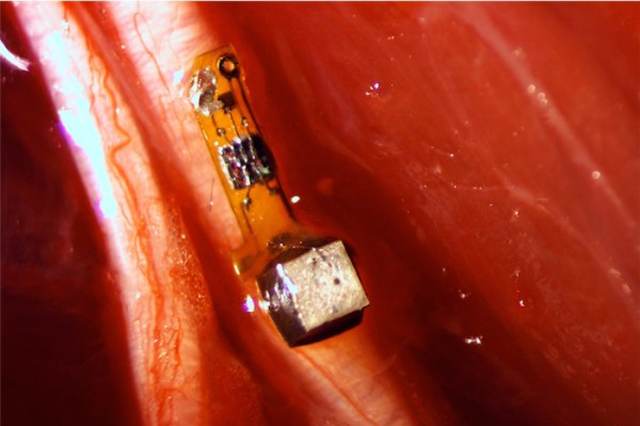What it is: A tiny encapsulated bit of circuitry, with sensors and a chip, that can be inserted into your brain (or actually, anywhere in your body), to check out the local conditions and report back.
Here’s the actual paper in Cell from the UC Berkeley scientists and here’s a bit about it on the tech site BoingBoing.
How it works: Don’t need no stinkin’ battery. Don’t need no wires, no holes in the skull. The ultrasonics used to query it also power it, through piezoelectrics, electricity that can be generated through the movement and flexing of certain materials. This version is 3 mm long (about 1/8”). Future, smaller versions could be powered by body movement or even the movement of the pulse. Other versions could be powered by the body’s own chemistry and electrical potentials.
Will it work? Yes. If this particular prototype does not lead to workable wireless batteryless microelectronics embedded in the body, it is at least the beginning of a technological drive that will eventually see doctors injecting hundreds or thousands of tiny sensor/transmitters that allow parts of the body as small as specific nerves to talk to the outside world. They could even talk to other parts of the body, allowing the brain of a paraplegic to send instructions to the legs, for instance. Or allow the physician to modify the conversation between gut bacteria and the brain, re-program the limbic system, or interrupt the positive feedback loop of brainwaves in an epileptic seizure.
The amount of processing power, sensing power, transmitting power in any one bit of neurodust is necessarily tiny. But using models of distributed computing we can imagine arrays of hundreds to thousands operating as a single computer arrayed throughout the body.
Such sensor/transmitters are a big part of the infrastructure of powerful medical science futures in which the blind see, the lame walk, or the body’s metabolism gets reprogrammed so that diabetes disappears and the pounds melt off.


Rodenberry sayin’ “told you so!”